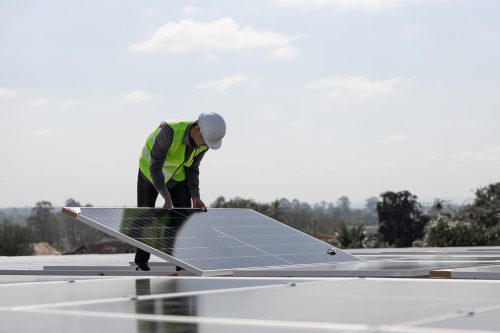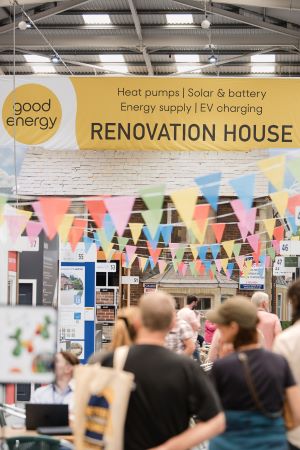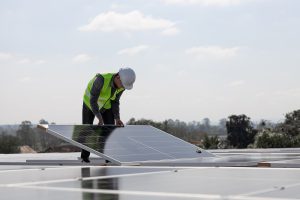South West councils lead the way for rooftop solar roll-out

Local authorities in the South West are outpacing councils in other regions as well as private homeowners in their rates of rooftop solar adoption, according to research by British solar company GRYD Energy.
9.4% of all residential property owned or leased by councils in the South West (8,150 homes) now have rooftop solar installed compared with 5.5% of council homes nationwide and 5% of privately owned UK homes.
South West councils that report the highest rates of progress are:
Council of the Isles of Scilly (52.5% of all council homes have rooftop solar)
Mid Devon District Council (39.7%)
Bournemouth, Christchurch and Poole (22.5%)
Teignbridge District Council (20.6%)
Exeter City (19.8%)
GRYD Energy co-founder and CCO Tom Jordan lives in Cornwall and says that the progress councils are showing across the region with their rooftop solar rollout is exciting.
“The South West has an excellent track record of leading the environmental charge. It’s extremely promising to see our local authorities making a real investment in rooftop solar to decarbonise their housing and unlock affordable clean energy for their tenants. There is still a long way to go, however, so it’s crucial to keep this momentum high.”
Last year, GRYD Energy launched a residential solar pilot in St. Ives, Cornwall that aims to unlock affordable clean energy for millions of UK households. The project is the first in the UK to test smart solar and battery storage systems for new-build homes that carry zero upfront cost burden for the developer or homeowner.
Jordan says: “The government has set ambitious goals to become a clean energy superpower by 2030. We have the technology and public support to make it happen – all we need is to apply the right solutions at scale rapidly.”
“Rolling out solar to residential rooftops across the region is a no-brainer,” says Jordan. “If our local authorities keep up this pace, we can cement the South West’s position as an environmental leader and challenge and inspire other regions to follow suit.”
On a national scale, local authorities in Wales and Scotland are reporting the highest rates of progress, with 8.4% of all council-owned homes in Wales and 7.9% in Scotland now benefitting from rooftop solar, compared with 4.9% in England and 3.8% in Northern Ireland.
Across the UK, the highest-performing regions are North West Wales and North East Wales where more than one in five council-owned homes (23.6% and 21.0%) have solar panels installed. The next highest region is Scotland’s Aberdeen and North East, where 13.5% of council homes now have rooftop solar.
Conversely, just 1.8% of council homes in London currently have rooftop solar installed. Low proportions of solar-powered council homes are also reported in Southern Wales (0.3%), South West Wales (1.9%), and Yorkshire and the Humber (2.1%).
“Many councils are already under immense financial pressure, so the fact that on a national scale they are outpacing private homeowners in their rooftop solar rollout is remarkable,” says Mohamed Gaafar, CEO and co-founder of GRYD Energy.
“But we’re still talking about very small numbers here and no one is really winning this race. Rates of rooftop solar deployment need to increase dramatically across the entire public and private housing landscape if we are to achieve the government’s clean energy targets by 2030.”
“Many councils own thousands of residential properties. Imagine the impact and momentum that could be unlocked to tackle the clean energy transition if councils were supported and incentivised by the government to deploy rooftop solar to those portfolios at scale.”
As debate intensifies around the recent approval of several large-scale solar farms across the UK, Gaafar says boosting deployment of rooftop solar could displace the need for many of these large-scale projects.
“Around 250,000 homes are built in the UK each year. That’s more than eight million square meters of prime solar roof space created annually – or 2,000 acres of solar farms that wouldn’t need to be built.
“Achieving the government’s ambitious green energy targets doesn’t need to be a contentious debate. Solar farms will certainly make an important contribution to Britain’s clean energy future, but we are missing a vital piece of the puzzle by overlooking the immense solar potential of Britain’s residential rooftops.
“When scaled, these independent systems can help millions of Brits to become energy independent and significantly reduce the burden on the national grid. They also don’t come with the potential widescale disruption for local residents that solar farms do or require the huge investment needed to upgrade transmission lines and distribution networks.
“Last year, Ed Miliband said he wanted the government to unleash a solar rooftop revolution. The government must now act on that ambition and put serious investment and policy support behind helping local authorities and homeowners to adopt the technology, become energy independent and reduce the burden on the national grid.”









